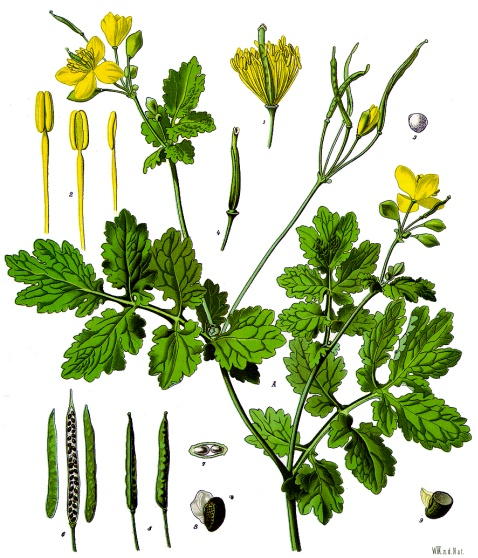Chelidonium majus (L)
Synonyms: garden celandine, tetterwort
Order: Papaveraceae
Description: Chelidonium is a member of the poppy family. A perennial, it has erect slender branching stems up to 60cm tall. The thin pale green smooth leaves are pinnate with toothed or lobed segments and with stalks often dilated into false stipules. Small yellow flowers occur in groups of three to six in loose umbels, giving way to smooth cylindrical seed pods. These and the stems produce a yellow foetid sap when cut. It inhabits waysides and waste places, and near habitation, in Britain, Europe, Asia and north-eastern North America.
Parts used: aerial parts, roots
Collection: The aerial parts are collected during the flowering period from May to June, the roots in late summer or autumn.
Constituents: alkaloids (allocryptopine, berberine, chelamine, chelidonine, chelerythine, coptisine, magnoflorine, protopine, sanguinarine, sparteine and others). The roots contain choline, histamine, tyramine, saponins, chelidoniol, chelidonic acid, vitamin C, yellow latex with carotenoid latex.
Actions: spasmolytic, cholagogue, bitter, alterative, diuretic, laxative, anodyne, purgative, caustic, anti-inflammatory, abortifacient
Indications: cholecystitis. Specifically indicated in gallstones. Topically, the juice has been used in eczema, verrucae and malignant tumours of the skin.
Therapeutics and Pharmacology: Chelidonium is stimulating to the liver and gallbladder. It is effective in the treatment of gallbladder infections and gallstones, and is often used as a constituent of prescriptions designed to clear the liver and bowel. It may be used as an antispasmodic remedy in stomach pain, and has also been used in the treatment of eczema and to remove cataracts. Externally, the orange latex from the stem may be used in the treatment of verrucae, skin tumours and tinea. The active principle is the alkaloid chelidonine, which has spasmolytic properties specifically directed at the bile ducts and the bronchi. However, results appear to be inconsistent; the medicinal action is greatly reduced on prolonged storage. The plant has narcotic properties and a reported anticancer activity; it has been found that chelidonine inhibits mitosis. The isolated alkaloids protopine, sanguinarine, chelerythrine and chelidonine have antibacterial actions and are antitussive too. Chelidonine produces mild but prolonged lowering of arterial blood pressure, increases the production of urine and inhibits or delays the development of anaphylactic shock.
Combinations: Chelidonium may be combined with Berberis and/or Taraxacum in gallbladder disease.
Caution: No harmful effects from therapeutic doses have been noted. Side-effects are mild and infrequent and include dry mouth and dizziness. At higher doses Chelidonium is poisonous, causing powerful purging of the digestive system, and should only be used under qualified supervision. It should not be taken during pregnancy. Chelidonium should not be confused with Lesser Celandine, also known as Pilewort (Ranunculus ficaria), to which it is not related.
Preparation and Dosage: (thrice daily)
Dried herb: 2-4g or by infusion
Liquid Extract: 1:1 in 25% alcohol, 1-2ml
Tincture: 1:10 in 45%, 2-4ml
Additional Comments: Celandine is named after the Greek word for the swallow, because it starts flowering when they arrive and stops when they leave. According to the Doctrine of Signatures, this plant, with its yellow juice, was deemed suitable for biliary complaints. In Chinese medicine it is used as an analgesic, antitussive, anti-inflammatory and detoxicant. Mrs Grieve states that it was used in Suffolk as a fomentation for toothache.
Bibliography
BHMA 1983 British Herbal Pharmacopoeia, BHMA, Bournemouth.
Grieve, M. 1931 A Modern Herbal, (ed. C.F. Leyel 1985), London.
Hoffmann, D. 1990 The New Holistic Herbal, Second Edition, Element, Shaftesbury.
Lust, J. 1990 The Herb Book, Bantam, London.
Mabey, R. (ed.) 1991 The Complete New Herbal, Penguin, London.
Mills, S.Y. 1993 The Essential Book of Herbal Medicine, Penguin, London (First published in 1991 as Out of the Earth, Arkana)
Mills, S.Y. 1993 The A-Z of Modern Herbalism, Diamond Books, London.
Ody, P. 1993 The Herb Society's Complete Medicinal Herbal, Dorling Kindersley, London.
Polunin, M. and Robbins, C. 1992 The Natural Pharmacy, Dorling Kindersley, London.
Weiss, R.F. 1991 Herbal Medicine, Beaconsfield Arcanum, Beaconsfield.
Wren, R.C. 1988 Potter's New Cyclopaedia of Botanical Drugs and Preparations, C.W.Daniel, Saffron Walden.










